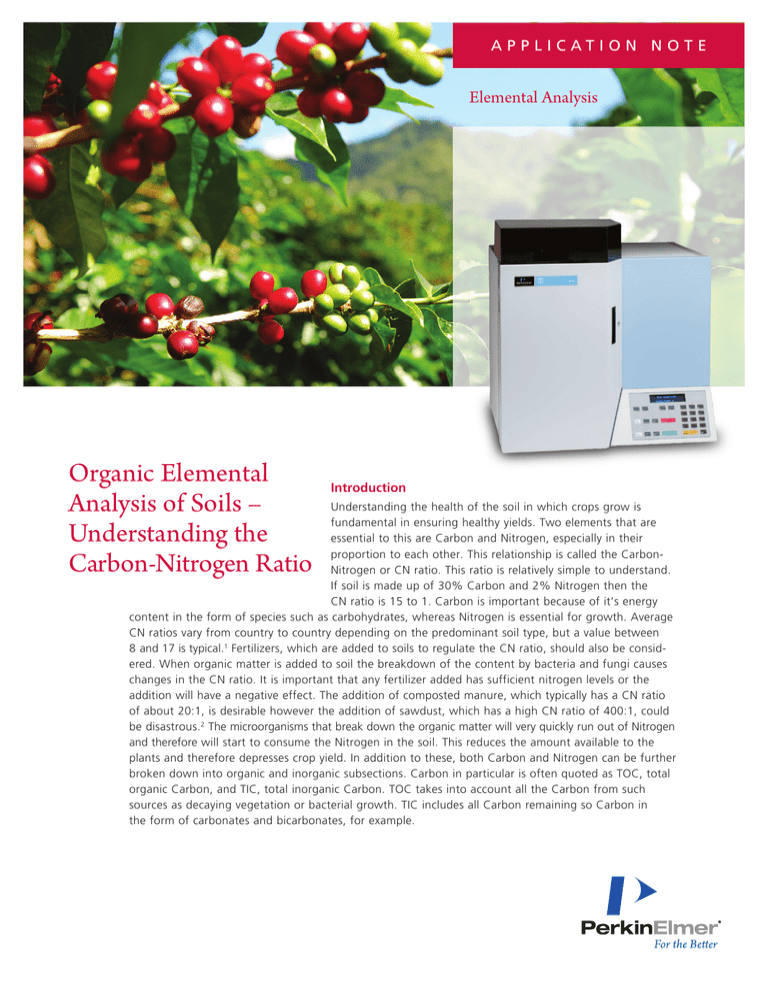
a p p l i c at i o n N o t e
Elemental Analysis
Organic Elemental
Analysis of Soils –
Understanding the
Carbon-Nitrogen Ratio
Introduction
Understanding the health of the soil in which crops grow is
fundamental in ensuring healthy yields. Two elements that are
essential to this are Carbon and Nitrogen, especially in their
proportion to each other. This relationship is called the CarbonNitrogen or CN ratio. This ratio is relatively simple to understand.
If soil is made up of 30% Carbon and 2% Nitrogen then the
CN ratio is 15 to 1. Carbon is important because of it’s energy
content in the form of species such as carbohydrates, whereas Nitrogen is essential for growth. Average
CN ratios vary from country to country depending on the predominant soil type, but a value between
8 and 17 is typical.1 Fertilizers, which are added to soils to regulate the CN ratio, should also be considered. When organic matter is added to soil the breakdown of the content by bacteria and fungi causes
changes in the CN ratio. It is important that any fertilizer added has sufficient nitrogen levels or the
addition will have a negative effect. The addition of composted manure, which typically has a CN ratio
of about 20:1, is desirable however the addition of sawdust, which has a high CN ratio of 400:1, could
be disastrous.2 The microorganisms that break down the organic matter will very quickly run out of Nitrogen
and therefore will start to consume the Nitrogen in the soil. This reduces the amount available to the
plants and therefore depresses crop yield. In addition to these, both Carbon and Nitrogen can be further
broken down into organic and inorganic subsections. Carbon in particular is often quoted as TOC, total
organic Carbon, and TIC, total inorganic Carbon. TOC takes into account all the Carbon from such
sources as decaying vegetation or bacterial growth. TIC includes all Carbon remaining so Carbon in
the form of carbonates and bicarbonates, for example.
These percentages can be ascertained by two techniques:
Kjeldahl and Dumas. Kjeldhal methods involve time consuming
and often complicated wet chemistry techniques, whereas
Dumas is a simple combustion procedure. Dumas organic
elemental analyzers involve combusting the soil matter in
the presence of Oxygen into simple molecules or gases such
as CO2, H2O and N and then separating these gases using
chromatography techniques. The PerkinElmer® EA2400
CHNS/O and EA2410 Protein Analyzers are classic examples
of these instruments utilizing combustion reagents and TCD,
thermal conductivity detection, to give high accuracy and
precision results.3 In the case of the EA2400, the Carbon/
Nitrogen percentages are outputted to database software
whereby the CN ratio can be calculated automatically. If the
TOC value is desired, then acidification of the sample can be
carried out to remove the inorganic Carbon species before
combustion.
Results and discussion
1. Silt loam soil
Weight percentages quoted in Table 2 are for the average of
three runs, with the first row showing the results of the as
received samples and the second row showing the results after
acidification using either hydrochloric or phosphoric acid.
Table 2. Elemental percentages of silt loam soil as an average
of 3 runs before and after acidification.
Average
Weight
%
Furthermore as:
Sample
Weight (mgs)
C
H
N
TC = TIC + TOC (1)
As Received
20-80
2.33
0.97
0.19
As Acidified
30-40
2.24
0.99
0.19
knowing the total Carbon and the organic Carbon (i.e. Carbon
percentage of acidification) allows calculation of total inorganic
Carbon.
Experimental
All samples were dried at 80 °C prior to analysis. Each sample was
placed in a tared large tin capsule (PerkinElmer, N2411362)
and precisely weighed using a PerkinElmer AD6 Autobalance.
Samples ranged in weight from 10 to 80 mgs. Due to the
high mineral content of the soils, the standard vial receptacle
(N2411335) was replaced with the quartz tube insert
(N2411401) to prevent devitrification of the quartz combustion
tube. All samples except the final batch were run on an EA2400
CHNS/O Elemental Analyzer with other samples being run
on the EA2410 N Nitrogen Analyzer.
To ensure complete combustion of the organic matter was
achieved, the following optimized combustion conditions
were adhered to and are shown in Table 1:
Table 1. Optimized combustion times for soil analysis.
2
Analysis time for the EA2400 measurements were around
5 mins, those for the EA2410 were approximately 4 mins.
For these experiments the following samples were chosen:
silt loam soil, fallow field soil, CANMET reference soils and
USDA reference soils.
Optimize Combustion
Time (Sec.)
Oxygen Full
3
Combustion Time
20
Oxygen Boost 1
2
Oxygen Boost 2
1
These results give us two important facets of information.
Firstly, we can ascertain that the CN ratio is 12 to 1 (12.26)
which, as stated previously, is the range which is common
for soils. Secondly, we can see that the total inorganic Carbon
content is low. The data gives a TIC of only 0.09%, whereas
the TOC is 2.24%. The high organic content is encouraging
for growing crops.
2. Fallow agricultural field soil
Two measurements were undertaken from a field that had
been left fallow for one year prior to measurement. The
results are presented in Table 3:
Table 3. Elemental percentages for fallow field soil for 2 runs.
Average
Weight
%
Run
Weight (mgs)
C
H
N
1
30.41
1.25
0.54
0.11
2
50.75
1.21
0.56
0.10
The results show that there is very little organic content in
the samples. This is as expected as the lack of plant life in
the prior year would lead to a lack of humus and therefore
organic content. Once again the CN ratio is 12 to 1 (11.71).
3. Canadian Centre for Mineral and Energy Transfer
(CANMET) reference soils
Variation in soil type is also an important feature to study.
For instance, soils from Savannah, Georgia have typically
high organic contents (C = 3.70-17.5%) whereas in Florida,
where soils are typically sandier, the organic content is much
lower (C = 0.18-0.58%). To investigate, these three soil
types were run and compared to reference values to confirm
accuracy. The results are shown in Table 4 with the EA2400
data being an average of 5 runs.
Table 4. Elemental percentages for 3 soil types averaged over 5 runs and compared to reference values.
EA2400
Weight
%
CAN.
Ref.
Values
C
H
N
C
H
N
0.31
0.52
0.04
0.25
0.52
0.04
Sample Weight (mgs)
1
10-50
2
4-25
4.78
0.72
0.20
4.80
0.73
0.22
3
4-25
6.63
0.14
0.03
6.60
0.15
0.02
Sample 1 – Champlain sea clay; Sample 2 – ferro-humic podzol; Sample 3 – gray brown luvisol.
The samples were interesting due to their varying CN ratios.
In the case of podzols, this variation is due to leaching of
nutrients by rain water resulting in soil that is poor for
agriculture. The results show that the sea clay has a CN
ratio of 8:1 (7.75), the podzol has a ratio of 24:1 (23.9) and
the luvisol has the highest ratio of 221:1. These values were
checked against reference values supplied by CANMET,
indicating that experimental results were in agreement.
It should be noted that due to the low organic content
of the sea clay a larger sample was used.
4. U.S. Department of Agriculture (USDA) reference soils
Samples from the USDA were also tested, this time using
the EA2410 Nitrogen Analyzer. The measurement was purely
for Nitrogen, but as the CN ratio was know to be 10:1 the
Carbon values could also be calculated. The results are
shown as an average of 3 runs in Table 5.
Table 5. Elemental percentages for USDA samples averaged
over 3 runs and compared to reference values.
EA2410
USDA Ref.
Sample
Weight (mgs)
%N
%N
1
10-50
0.24
0.23
2
10-50
0.41
0.39
3
10-50
0.15
0.13
The results indicate excellent synergy with the reference
values. Using the CN ratio of 10:1 it can be calculated that
Carbon values are approximately 2.4%, 4.1% and 1.5%.
Conclusion
The EA2400 CHNS/O Analyzer is shown to be a powerful
tool for the analysis of soil samples of varying organic
contents. It is shown that along with CN ratios, TOC and
TIC measurements can also be performed to a high level of
accuracy. It has also been shown that the EA2410 Nitrogen
analyzer can also perform Nitrogen measurements on soil to
high levels of accuracy.
References
1.Alistair F. Pitty, Geography and soil properties, Taylor &
Francis, 1979.
2.Crow Miller, Understanding the Carbon-Nitrogen Ratio,
2000, 30, Issue. 4, Pg. 20.
3.Robert F Culmo et al., Methods of Organic Nitrogen
Analysis: Kjeldahl and the EA2410 N Analyzer (Dumas
Method), PerkinElmer publication EAN-8.
3
PerkinElmer, Inc.
940 Winter Street
Waltham, MA 02451 USA
P: (800) 762-4000 or
(+1) 203-925-4602
www.perkinelmer.com
For a complete listing of our global offices, visit www.perkinelmer.com/ContactUs
Copyright ©2010, PerkinElmer, Inc. All rights reserved. PerkinElmer® is a registered trademark of PerkinElmer, Inc. All other trademarks are the property of their respective owners.
008683_01



